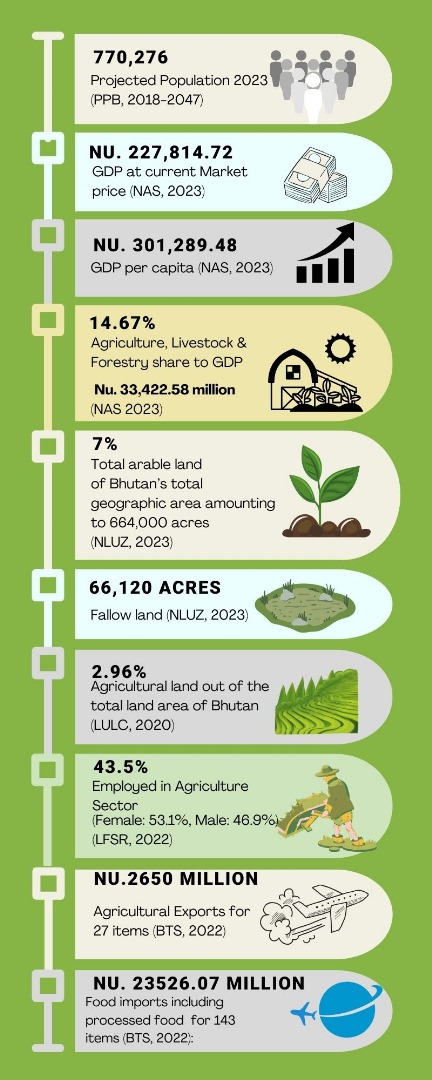The formulation of the 10 FYP has been guided by the directions provided by Vision 2020; MDGs; poverty alleviation and in the strategic push in MoAL to strengthen marketing, access and production. Since by far most of the people living under the poverty are rural, MoAL has a special responsibility and role in poverty alleviation. Although, there has not been a specific poverty strategy for poverty alleviation, the sector has prepared the RNR food security strategy paper and also carried out a food security vulnerability mapping which will guide identification of strategies and coverage of programs for poverty alleviation through the RNR sector.
Sector Objectives
- To enhance sustainable rural livelihood
With 69% of the population living in the rural areas engaged in economic activities that are based on the natural resources, enhancement of rural livelihood will be an important development objective of the RNR sector. Making rural livelihood productive and sustainable will form a core element of this objective.
VISION
Typically, rural livelihood in Bhutan is supported by farming which is characterized by inherent inter-dependence among forests, livestock and agricultural enterprises. Therefore, enhancement of rural livelihood will involve improvement of economic returns from these enterprises. Improvement of economic value of farm enterprise will be pursued through intelligent development, utilization, and management of forest, agriculture and livestock resources. Productivity of these resources will be enhanced through application of production boosting technologies, mechanization of farming, reduction of post–harvest losses, reduction of losses incurred by pest and diseases, application of information and communication technology, and improving vital farm infrastructure and production inputs. Commercialization of farming, integration of farm enterprise into market through enhanced connectivity, upstream improvement of farm products, product specialization, improvement of trading of farm products, professional management of farm enterprises, and application of information and communication technology to integrate farm enterprise into the market are critical elements of enhancing sustainable rural livelihood. Professional management of farm enterprise will be promoted through vocational training of progressive and enterprising farmers. Vocational training will address capacity requirement associated with commercialization of farming.
Commercialization of farming and diversification of utilization of forest resources will be promoted to facilitate development of rural-based small-scale industries to process and add value to the products. Through this alternative employment and livelihood opportunities will be enhanced. The pursuit of this objective will lead to increase in food production and enhancement of cash income to the rural population and contribute to poverty alleviation.
- To promote sustainable utilization of arable agriculture and pasture land resources
Sustainable utilization of arable agriculture and pasture land resources is crucial for poverty alleviation and enhancement of rural livelihood since food security and income generation – two crucial elements of poverty – are dependent on agriculture and livestock enterprise. Arable agriculture land is the basic resource for agriculture development as much as pasture land is basic to livestock development. Therefore, sustainable management of arable agriculture and pasture lands will receive more attention in the 10th Plan. A typical Bhutanese farm economy is characterized by functional interdependence between agriculture and forest, livestock and agriculture, and forest and livestock. Nutrient replenishment and structural improvement of agricultural land depends on the flow of biomass from the forest through direct application of compost manure or livestock manure. The watersheds are the sources of water for irrigation and livestock consumption. The forest supplements the pasture lands in providing feed and fodder for cattle. In addition, forest provides a host of resources to support the livelihood of farming communities. The functional interdependence between forest and agriculture will be maintained in perpetuity and enhanced where necessary to enhance sustainable utilization of arable agriculture land resources. As part of this objective conscious review of how this interdependence is being vitiated will be carried out and necessary measures will be initiated to restore and strengthen. Institutional and management arrangements will be enhanced to add impetus to sustainable utilization of pasture land resources. Logically, management practices will be improved to enhance the productivity and carrying capacity of pasture lands. Through this, economic returns will be enhanced and negative environmental consequences associated with overgrazing will be reduced. Eventually, increase in the productivity and the carrying capacity of pasture lands will be cashed on and turned into a means to reduce the incidence of grazing in the forest and reduce the problem associated with multiple uses of forest resources.
- To enhance food security
Securing access to food is a basic human right and guaranteeing this has been a principal policy objective of the Royal Government for many years. For instance, the land reforms implemented in the 1950s and 1980s were aimed at equitable land ownership, preserving prime agricultural land, and promoting self-sufficiency in cereals to ensure food security to the population. As a result, although the income and material living standard of many Bhutanese people’s are low, particularly in rural areas, the incidence of abject poverty and hunger is nonexistent in Bhutan. Indeed, this can be attributed to the welfare-oriented development policy inspired by the concept of Gross National Happiness. For long, food security in Bhutan has been narrowly equated with enhancing food availability through striving to attain an appropriate level of food self-sufficiency. Securing access to food and effective utilization of food has been neglected. However, it is now recognized that food security means ensuring food availability, securing access to food, and effective utilization of food. The overall goal of the Tenth Plan is alleviation of poverty. Since poverty is attributive of unavailability of food, lack of access to food, and ineffective utilization of food poverty alleviation has to address all these three issues together. In the Tenth Plan the sector will address poverty by enhancing food security through increasing food availability and securing access to food.
To enhance food security food production will be increased and access will be secured through enhancement of cash income of rural population. Since rice is the most preferred staple cereal at the moment, it is aimed at achieving a 50% self sufficiency through domestic rice production.
![]()



